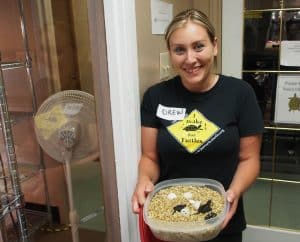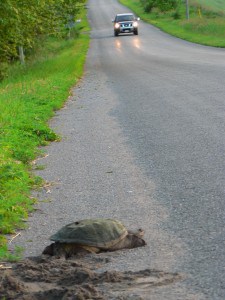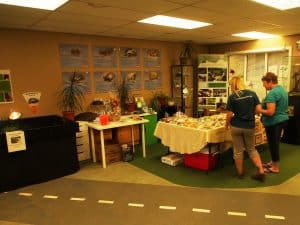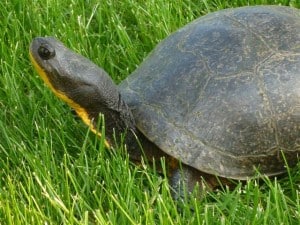My passion for nature began with turtles. Catching these wary reptiles was one of my favourite pastimes as a child. I was especially proud whenever I managed to bring home a snapping turtle, keep it for a day or two and show it off to my friends and family. I was therefore pleased to learn that the Ontario government has finally decided to ban the hunting of this increasingly rare species. This is a huge step forward for turtle conservation and a victory for science-based decision making. Like all of Ontario’s turtles, the snapping turtle cannot tolerate additional losses to its adult population. The hunt was not sustainable, especially on top of other pressures such as habitat loss and road mortalities.
In late May and June, turtles are searching out nesting sites, such as the fine gravel of road shoulders. This is when people most often see turtles. However, turtle eggs stand a very poor chance of surviving the 90-day incubation period. Predators such as raccoons and skunks usually discover the nests within a matter of hours, dig up the eggs and enjoy a hearty meal. They leave behind the familiar sight of crinkled, white shells scattered around the nest area.
Roadkill, too, is a major cause of turtle mortality, especially at this time of year. Even worse, many of the turtles killed or injured are females on their way to lay eggs. Killing pregnant females not only removes reproductive adults from the population, but it also means all their potential future offspring are lost as well. Always drive carefully and keep an eye out for turtles on the road.
Ontario Turtle Conservation Centre
Sadly, numerous turtles continue to be hit by cars or injured in other ways. This is where the Ontario Turtle Conservation Centre (OTCC) comes in. Located at 1434 Chemong Road in Peterborough, the OTCC has been working since 2002 to protect and conserve Ontario’s native turtles and their habitat. It is the only wildlife rehabilitation centre dedicated solely to providing medical and rehabilitative care to Ontario’s turtles.
Home to the Kawartha Turtle Trauma Centre, the OTCC operates a hospital, which treats, rehabilitates and releases injured turtles. From an average of 50-80 turtles in the early years, the Centre now receives about 500 turtles each year as more people across Ontario learn about its work. The OTCC also carries out extensive research in the field and runs a comprehensive education and outreach program. The Executive and Medical Director is Dr. Sue Carstairs, who is an authorized wildlife custodian with over 20 years of experience in wildlife medicine.
Because so few turtles ever reach sexual maturity – females don’t even reproduce until the age of 18 – each adult turtle is part of an extremely important group. This is why it’s so important to rehabilitate as many injured turtles as possible – especially females – and return them to the wild. According to Dr. Carstairs, the most recent figures show that 1400 eggs are required to replace just one mother snapping turtle. However, as long as turtles can avoid threats such as road traffic, they can live and breed for a long time. It is believed that snapping turtles have a lifespan of over 100 years.
The OTCC is supported by a province-wide network of veterinarians and wildlife centres, including more than 30 different “first response centres”. Over 100 volunteers then drive the turtles from across the province to Peterborough. In this way, the “patients” are admitted to OTCC quickly for ongoing care. Once stabilized with fluids, painkillers, antibiotics, and wound management, each turtle is x-rayed to check for internal injuries and to see if the females are gravid (pregnant). If so, they are usually induced to lay their eggs. With deceased turtles, the eggs are removed surgically. In both cases, the eggs are then moved to a nest container and incubated in the turtle nursery. Most hatchlings are quickly released in the marsh or pond closest to where their mother was found. However, babies from eggs that hatch late in the fall are kept over the winter and released in spring.
Because a turtle’s shell is made of bone, putting a fractured shell back together is orthopedic surgery. A number of different methods are used, depending on the type of fracture. Internal injuries, however, are the most life threatening. Like other injured animals, turtles go into shock, which means that timely care is of the essence. Other common medical interventions include repairing fractured jaws, removing fish hooks and treating everything from infections to pneumonia.

Drew Maxwell, a volunteer at the OTCC holds newly-hatched snapping turtles. The Centre treats injured turtles from around the province, many of which are injured after being hit by vehicles. – Drew Monkman
Education
Because education is the key to turtle conservation, the OTCC offers a number of carefully tailored presentations both off- and on-site. Audiences range from kindergarten students all the way to cottagers associations. Their Chemong Road location houses a 1000 square foot education centre. It is home to non-releasable education turtles, interactive displays and a great gift shop. Visitors can enjoy behind-the-scenes viewing of the hospital, the rehabilitation centre and adorable baby turtles! The education centre also includes a new outdoor area with ponds, trails and informative signs.
What you can do
1. If you come across an injured turtle, take note of the exact location where you found it. Place the animal in a plastic container with a secure lid and wash your hands. Call the OTCC at 705-741-5000. The Centre is staffed seven days a week from 8 am to 8 pm. NOTE: Never attempt to treat any sick or injured animal, no matter what it is. In the case of birds and mammals, contact a licensed Wildlife Rehabilitation Centre by going to owren-online.org
2. If you encounter an uninjured turtle in the middle of a road and traffic conditions are safe, gently move the animal in the direction it is travelling. Snappers can be coaxed across using a shovel, board or big stick. Never pick up a turtle by its tail.
3. If you know of a road that is particularly dangerous for turtles, contact your local councillor or other elected official to see if warning signs can be erected.
4. Do not dig up nests to protect the eggs. If you are concerned about predators, you can build a turtle nest cage. Instructions can be found at torontozoo.com. Search for a pdf called “Turtles on your Property”. Remember to keep an eye out for hatchlings from late August until snow. Hatchling painted turtles sometimes overwinter in the ground and appear in spring.
5. If you are a lakeside property owner, keep your shoreline as natural as possible. Leave an un-mown buffer of vegetation that extends at least 10 metres deep back from the water’s edge. Leave any fallen logs that lie on or close to shore.
6. You can help to conserve turtles (and other reptiles and amphibians) by reporting your sightings to monitoring programs such as the Ontario Reptile & Amphibian Atlas at Ontarionature.org
7. The OTCC exists primarily thanks to a team of dedicated volunteers, which assist with turtle care, outreach and fundraising. If you are interested in volunteering, visit the website or phone 705-741-5000.
Ontario’s turtles
Ontario is home to eight species of turtle, six of which can be found in the Kawarthas. The only species that are not found locally are the wood and spiny softshell turtles. No less than seven of our province’s turtles are now listed as Species at Risk.
1. Midland painted turtle: This is our most common and widespread species. It is named for the bright yellow, orange and/or red streaks on the head and neck.
2. Snapping turtle (at risk): Easily identifiable by its often massive size and the serrated edges at the rear margin of the shell, the snapping turtle is most often seen in May and June when it is nesting.
3. Blanding’s turtle (at risk): This species has a dome-like shell and bright yellow throat. It is still quite common in the Kawarthas.
4. Musk turtle (at risk): This small, often algae-covered turtle, frequents shallow bays. It rarely leaves the water.
5. Map turtle (at risk): The shell of this large but wary species is covered by a network of map-like lines. The head and neck are streaked. They are often seen sunning themselves on the rocks of large lakes like Rice and Stony.
6. Spotted turtle (at risk): Small and secretive, spotted turtles have a smooth black shell with conspicuous bright yellow spots. There have only been a handful of confirmed sightings in the Kawarthas in recent years.
7. Wood turtle (at risk): This semi-terrestrial species spends most of its time on land in summer, inhabiting fields and forests near streams. Its shell looks like a piece of wood.
8. Spiny softshell turtle (at risk): This is a highly aquatic species found mostly in the Great Lakes and in large rivers. It lacks the horny plates on its shell that most turtles have.
Ontario also has one non-native turtle, the red-eared slider, which is superficially similar to the painted turtle. It is sold in pet stores. Unfortunately, disenchanted owners continue to release sliders into the wild, where they represent a threat to native turtles.
Shell-abrate!
To celebrate the banning of the snapping turtle hunt, the OTTC will be hosting a fundraiser in Toronto on June 15. The event takes place at Torys LLP, located at 79 Wellington Street West. Tickets are $95 each, but come with a $45 tax receipt. There will be a short documentary on the Centre’s work, a silent auction, interactive displays and a chance to meet OTCC’s ambassador turtles!
To learn about all OTCC happenings such as regular open house events, visit ontarioturtle.ca.


